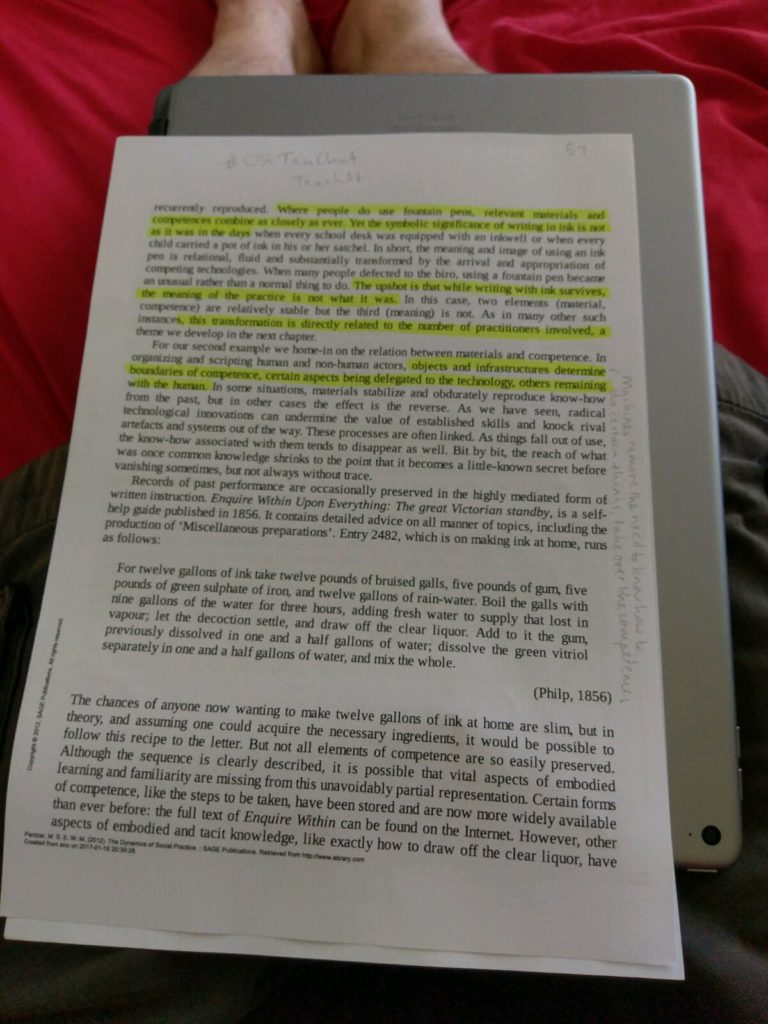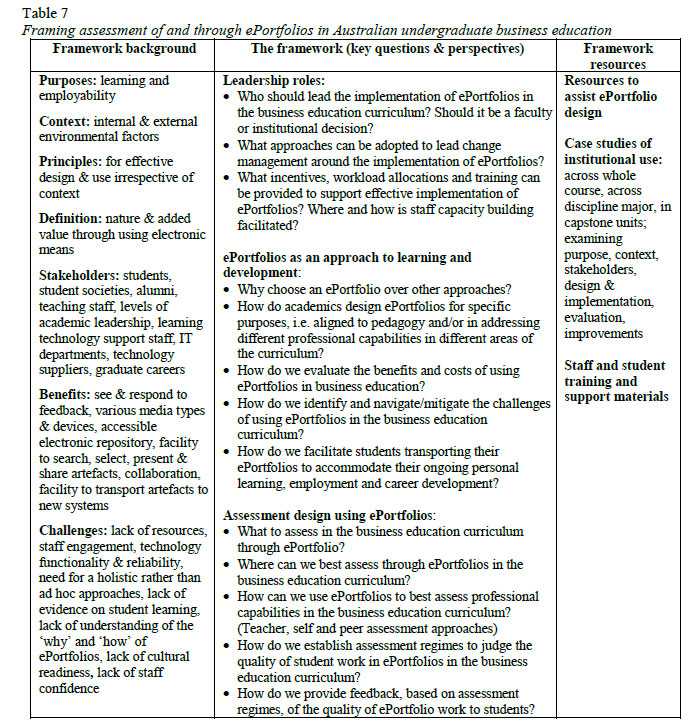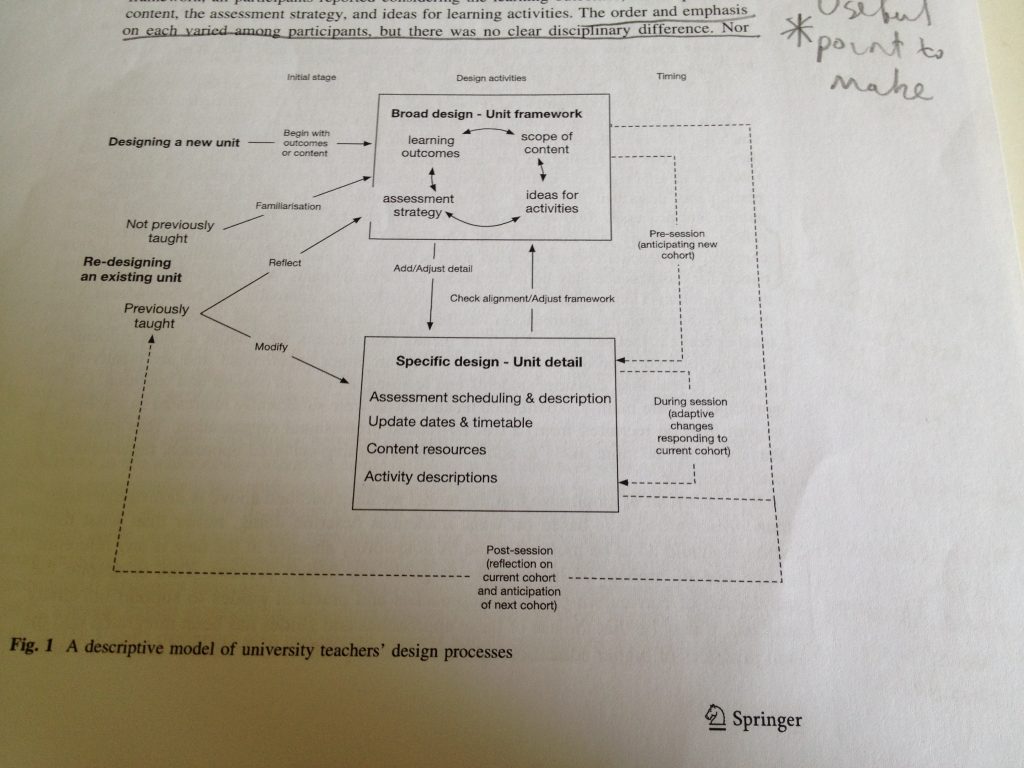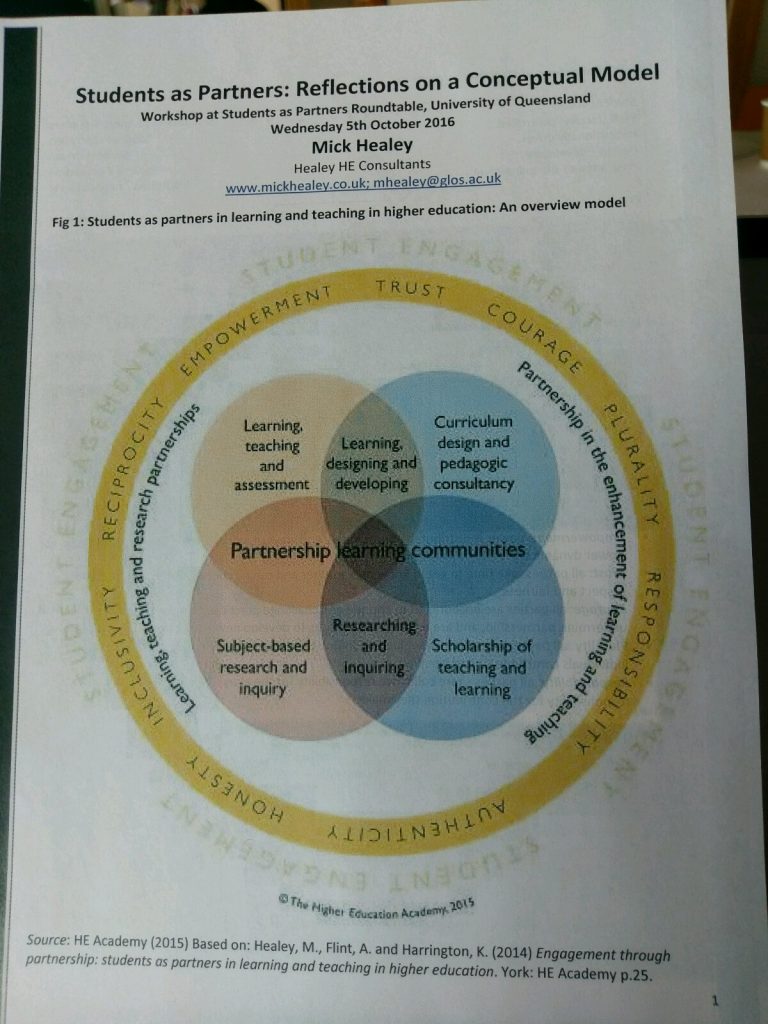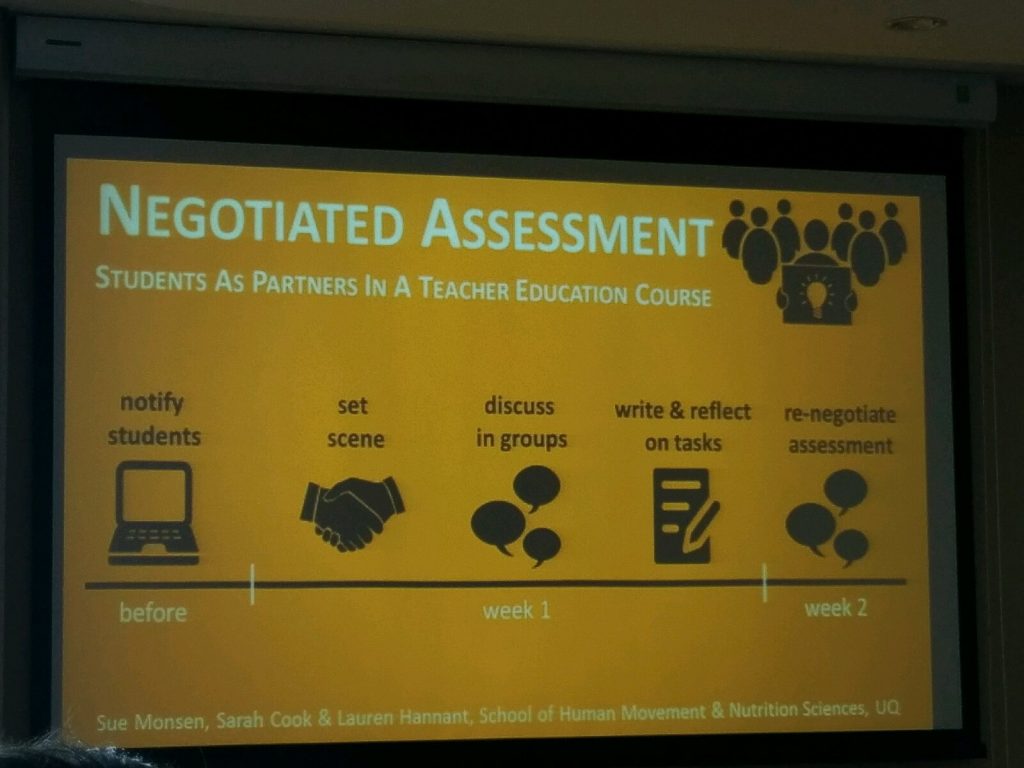Having set out the case for defining practice as the interwoven relationship between three key elements; materials, meaning and competences (I always want to say competencies here) in Chapter 1 & 2, the authors move on to examine how the elements can exist independently, how they (and by definition, practices) move from place to place and how practices emerge, disappear and persist.
I’ll be honest, it gets kind of meta in some places and there’s a degree of toing-and-froing (which they acknowledge) between the idea that in a practice, the three elements can or can’t exist without each other. We seem to land on the fact that clearly they can but the practice itself can’t exist without them all.
The good news is that the more I read of this, the more it seems like a nice theoretical hook to hang my research on. So far I can generally accept the ideas that are being put forth and I’m starting to substitute TELT practices into their other examples to see how well they fit. It’s all got me thinking about practices in a new way that I think might help me to pin down how I plan to actually conduct this research. (Spoiler alert, after having the grandest of ambitions for a massive multi-part research project last year, I’m realising that something more modest would still be perfectly acceptable)
Here are some of the core ideas put forward in this chapter, some useful supporting quotes and some of my stray ideas, questions and observations. (Quick note to self – reading this as an e-book means that there are no proper page numbers – the front cover of the book is considered page 1 – so double check the page numbers for quotes that you actually plan to use)
Practices constantly evolve while their component elements tend to stay more stable.
As structured and situated arrangements, practices are always in the process of formation, re-formation and de-formation. By contrast, elements are comparatively stable and are, as such, capable of circultating between the places and enduring over time. We are consequently surrounded by things that have outlived the practices of which they were once a vital part… Abandoned biscuit presses, outdated computer equipment and tools for tasks no longer undertaken are obvious examples but understandings, meanings and types of expertise are also discarded as practices evolve. (p.46)
The authors make a sweeping statement that I’m still considering on a philosophical level but looking around my desk at all of the ‘made’ objects (materials), it kind of makes sense. I’m trying to think of things, skills or meanings that we don’t have a use for that we do these things with. I have half a thought that there would be practices that are “carried” or move between locations based on new ideas about uses of material items but I’m not yet sure what that means to me.
…it is only through their integration in practice that elements are reproduced, eroded or carried from one setting or population to another (p.47)
The fact that requisite elements co-exist does not guarantee that they will be linked together but the potential is there (p.47)
The question of access to specific materials needed for practices is raised and ties to the development of different technologies (trains, trucks, planes etc) that mean that access options change and thus associated practices can emerge or evolve. I’d say that the Internet sits nicely in that category of access when it comes to the material elements of TELT practices – though I’m curious about where exactly software and web services sit. They’re on one hand a thing that people use but on the other, contain certain knowledge/competences that save people from having to carry out particular sub-practices in the course of doing larger practices. But perhaps that is just what tools (materials) do? Hopefully we’ll go deeper into the crossover between materials, tools and competences.
There’s also the question of what impact the choice of specific materials in a practice means – some materials playing better with others and creating opportunities to do some things but not others. (Which feels like another of the many areas where these ideas cross paths with sociomaterial theory). I definitely think there’s room in my research for a look at what impact the choice of particular technologies has on practices.
At this point, the authors observe that in terms of practices moving from place to place, the issues faced in terms of the material elements differ from those related to competences and meaning.
Rather, the point is to recognise that whereas forms of (co)location, transportation and access are typically important for the diffusion of material elements, forms of competence and meaning circulate in characteristically different ways (p.49)
The authors go on to explain that they appreciate the importance of the human factor in learning/developing competences but also that they are more interested in the wider question of how competences travel between practices as well as between people. I can accept that this is the nature of the theory that they are formulating but I’m also mildly concerned about the extent to which they have been discarding complexities in the pursuit of an argument.
I do still think that there is merit in what they are exploring though, so it might just need to be a matter of remembering to re-add these factors down the track when I’m doing my research. The practice of in-person learning-by-doing in a teacher/student relationship seems kind of pertinent when we’re looking at interventions to pass along skills and knowledge (competences), rather than looking at them in the abstract. Maybe we’ll get back to this later in the book – I believe the next chapter is about how people are recruited to practices.
When looking at how competences travel, particularly between different contexts, the authors talk about ‘abstracting’ and ‘reversal’ as core parts of the process. By ‘abstracting’, they mean stripping away localisations in the knowledge/skill that wouldn’t apply everywhere to leave the essential ‘knowledge’. On arrival at the new location, this ‘abstracted’ knowledge needs to be ‘reversed’ so that it again becomes contextually relevant.
Personally I don’t feel that ‘abstracted’ or ‘reversed’ (moreso the latter) really work well in terms of capturing these concepts. My video background makes me lean more towards encode (or code) and decode, from the Codec software used in the process of creating and sharing video files. (But maybe these aren’t perfect either).
The basic idea that knowledge has to be ‘abstracted’ form a local situation before it can travel, and that it needs to be ‘reversed’ when it arrives in some new destination, complicates popular interpretations of knowledge transfer as a simple process of sending and receiving. This representation is, however, consistent with an account of practices as integrative performances in which elements are conjoined. The suggestion that abstract knowledge circulates between such moments or sites of enactment is also relevant in thinking about how competences circulate (p.49)
This new space that the competences can sit in between the start point and destination is another thing that I’m still trying to grasp. Is it just a verbose way of describing publishing and documenting of knowledge of activities within practices?
Theories of abstraction and reversal depend on distinguishing between local understanding on the one hand, and what Disco and van der Meulen (1998) term ‘global-level cognitive ‘cosmopolitan’ knowledge, that is, knowledge that has been dis-embedded from its local origins and is consequently capable of travelling widely whilst maintaining its own integrity. As discussed in Chapter 2, this idea brings with it the related, and somewhat strange, image of knowledge temporarily existing in limbo, contained in what Arie Rip describes as a dislocated holding tank or reservoir, carried by what one might call an epistemic community and knowledge users pick up their own new combinations from the reservoir (1998). This vision of a gigantic depot of abstracted, de-contextualised buy not yet re-embedded knowledge is intriguing, as is the related suggestion that resources like libraries and the Internet, along with material objects and systems of regulation and certification, harbour pools of knowledge that have been variously certified, legitimated and prepared for travel (p.50)
I find the idea of the Internet acting as a reservoir of ‘cosmopolitan’ knowledge interesting but would argue that there is an abundance of local knowledge as well. Fortunately, the authors choose not to dwell on the reservoir, though I imagine I’ll go back to this, and move on to questions around what “has to be done to make knowledge movable (decontextualization and packaging), to let it move (infrastructure) and to make it work elsewhere (contextualization, standardization) (Deuten, 2003: 18)” (p.50)
Having the skills to decode is seen as it’s own special form of know-how and Shove et al suggest that this ability is often tied to pre-existing related knowledge of the competence.
This suggests know-how can only travel – by means of abstraction and reversal – to sites in which practitioners are already prepared to receive it because of prior, first-hand, practice based experience (p.50)
I’m broadly ok with this but think it ignores the capacity of teachers at the arriving end to teach inexperienced people these new skills. Maybe (and I’d suggest often) the teachers come from the originating place to run training and then leave. Clearly it’s easier for people to learn something (and teach it) if it can be connected to existing scaffolded knowledge but it’s far from impossible otherwise. I guess learning how to learn comes into this somewhere as well. The importance of standards and regulations relating to practices can’t be underestimated either, in that it increases the quality of the practices which would be an incentive to participate.
The extent to which competences can be used in a number of different practices is also a key factor in their transportability.
The concept of transferable skills is relevant in this regard. Having been mastered in one setting, competences like those of controlling a ball or speaking in public can be carried over and reproduced in others… This does not necessarily involve recognizable stages of abstraction and codification. Instead, specific competences are transferable because they are common, or at least common enough to a number of different practices (p.51)
This leads us to the question of whether we can reframe the way that we think about the contexts in which certain practices prevail as a way to foster the transfer of competences. In order to help sell more home appliances (e.g washing machines), there was a push in the late 18th century to move the ‘efficient practices and attitudes’ of the business world into the home. This was largely intended to change attitudes to housework that made it easier to sell the time/labour saving benefits of the new technology. (It probably wasn’t done with a specific understanding of social practice theory but they knew what they were doing)
Developing these ideas, certain elements of know-how bridge between practices not by means of abstraction and reversal but by somehow constituting – and potentially changing – the texture and the quality of the social fabric in which many such practices were rooted (p.52)
This brings us along neatly to the final element of the trio, meaning.
One thing that occurs to me here is the necessity of shifting the culture in Higher Education to one that is more willing to embrace TELT practices. I’ve been considering trying to appeal to the notion of scholarship in this regard – academics don’t suddenly stop researching and learning about their disciplines so why should teaching be any different. At the same time though, it is different and getting academics to look at teaching from a different mindset than their research one is a clear goal. Whereas research is a relatively individualistic practice, teaching is better explored collectively. I don’t kid myself that getting this message across will be easy but I think it’s valuable.
On that note, emotions and feelings seem to be an important factor in determining what practices a teacher will and more importantly will not embrace. My suspicion is that they have far more impact than any rational arguments in favour of doing a thing and my question is, how do we examine and address them. Do they sit in the meaning element or kind of alongside? Is this an area that people have looked into deeply – I’ve seen plenty of work about attitudes but I don’t think this is what I need.
The authors accept that the question of meaning is complex and it could be very easy to get caught up in discussions about local/personal meaning and disputed meanings. Once again, they choose to simplify this to pursue their core ideas about “how elements of meaning diffuse and what this means for the circulation of practices in and of which they are a part” (p.53)
Linking new knowledge, ideas and meanings to existing ones is identified as a core element of this. Firstly however, the authors identify the need to isolate meaning related to practice from the meaning attached to which groups in society (and their attendant status) participate in this practice.
The dynamic relation between the status of participants and the meaning of the practices they carry is widely discussed, usually with the aim of understanding how social and cultural hierarchies are reproduced and sustained. By participating in some practices but not others, individuals locate themselves within society and in doing so simultaneously reproduce specific schemes and structures of meaning and order. In Bourdieu’s terms, all cultural practices are ‘automatically classified and classifying, rand ordered and rank ordering’ (1984: 223). … In other words, the interest in what Nordic Walking says about the person who does it, not in how meanings like those of outdoor life circulate between practices or in how they combine with or break away from other symbolic constructs. By contrast, we want to put the element of meaning at the centre of our enquiry (p.53)
While it’s not what the authors intend, this discussion of the ties between status and meaning suggests to me that, in my work, I should consider opportunities to link the use of TELT practices with being a more well-rounded scholar.
Shove et al clarify what they hope to do by shifting focus from the people to the meanings nicely here
But in the context of the present discussion the question is not ‘Who determines whether smoking cigarettes and driving fast cars is transgressive or cool?’ but rather “How are categories like those of being cool, healthy or youthful populated with practices, how does this population change and with what consequences for these frames of meaning?’ (p.54)
Discussion of meaning meanders a little here, largely because the authors acknowledge that it is complex and not something that any one practitioner is able to shape. They point out that meaning changes and is “extended and eroded as a result of dynamic processes of association” (p.54) and also that meanings can merge into larger meanings – such as youth culture becoming seen as part of ‘Americanization’ (p.54). Their key point though is that meaning is often mediated – or at least people/groups attempt to mediate it and spread it though the community.
The catch is that while the media has a vital role in disseminating ideas, pictures and texts, there is no guarantee that these will stick. As with the abstraction and reversal of competence, the decoding and appropriation of meaning is an inherently local, inherently uncertain process. In addition, opportunities for association and re-classification are, to a degree, constrained and enabled by existing patterns and distributions of meaning (p.54)
In other words, you can try to shift meanings to embed new practices but don’t count on being able to do so. (This is perhaps where the authors’ preference for simplifying complex ideas lets them down.) I can still see the value in trying though and off the top of my head, I would think that desirable meanings to have associated with TELT practices would include; innovation/ being up to date, caring, quality and connection.
One of the things that I’m liking the most about this book is that the authors are strong on their structure and their process for building an argument. They start and end each new idea (or set of ideas) with a robust summary of the key points. There’s a solid summary of the six key ideas that we’ve just worked through on page 55. (I’m not including it because I think I’ve covered it already) . They then return to the central theme, that the elements are interdependent in practice.
Although we have discussed them separately, competence, material and meaning are often so closely related that if one element should travel alone (abstracted and packed in isolation), it is likely to remain dormant until joined by others capable of bringing it into the frame of a living practice. This observation reminds us that the relevant elements need to co-exist if practices are to extend or endure (p.55)
Emergence, disappearance and persistence
The final section of this chapter is somewhat shorter than the rest but continues to explore interesting territory. I’ve previously looked at this idea under the concept of ‘change and continuity’ – introducing new practices but supporting effective current ones as well. The tertiary education sector in Australia (and I imagine globally) has undergone massive change in some ways over the last 30+ years and this has, I believe, led to change-fatigue and a mistrust of ‘innovation’. This mistrust of innovation in general dates back far further than this, clearly – remembering the Luddites – and the authors find a great quote to sum it up
innovation of this sort disrupts and destroys. It changes the technology of process or product in a way that imposes requirements that existing resources, skills and knowledge satisfy poorly o not at all. The effect is thus to reduce the value of existing competence, and in the extreme case, to render it obsolete. (Abernathy and Clark, 1985: 6) (p.56)
In TELT terms, this makes me think of the SAMR (Substitution, Augmentation, Modification, Replacement) model, which sets out perhaps a gentler set of steps to climb in innovation.
Shove et al’s main point here appears to be that as some practices emerge, they replace others which fade into redundancy. Their component elements may or may not go down the same path, depending on whether they can be repurposed elsewhere.
Practices themselves might change – such as the act of writing with ink, which went from quills, to fountain pens and then to biros. The competence stayed largely the same – though the skills needed to manage the materials changed – but the materials changed greatly. The meaning of using a fountain pen 80 years ago (functional) also changed in comparison to those who use it now (luxurious).
It was at this point, as I was reading about changes in practice and materials that I noted that I was writing notes on a printed piece of paper with a pencil while leaning on the back of a new iPad. I had read previous chapters as an eBook on the iPad but wasn’t happy with the way that I was able to take notes and make comments directly on the text. I’m not entirely sure what this means but it seems interesting at the very least. I guess it’s that the material still needs to be fit for purpose and we will change our practices based on what works best for us. Perhaps there’s something in there about the precise affordances offered by the materials and the emotional responses that we have to them – I do like the tactile nature of pencil.
The text that I was reading at the time seems particularly apt
For our second example, we home-in on the relation between materials and competence. In organising and scripting human and non-human actors, objects and infrastructures determine boundaries of competence, certain aspects being delegated to the technology, others remaining with the human. In some situations, materials stabilise and obdurately reproduce know-how from the past, but in other cases the effect is the reverse. As we have seen, radical technological innovations can undermine the value of established skills and knock rival artefacts and systems out of the way. These processes are often linked. As things fall out of use, the know-how associated with them tends to disappear as well (p.57)
There’s a particular point made in here about machines removing the need to have know-how to do certain things, effectively taking over competences. This is definitely something that I’ll be thinking over in more depth.
Shove et al sum up this section as follows
In describing instances of emergence, disappearance and persistence we have noticed that relations between elements may vary as patterns of participation change. We have shown that material elements transform, carry and preserve forms of competence; that instructions are useful in keeping knowledge in circulation but that more [performance] is required to keep it alive; and that elements of meaning are capable of hopping from one practice to the next (p.59)
So what do I take away from this?
It’s useful to consider how the elements function and move and evolve in their own right and it is equally important to remember that their relationships with their other elements have a significant impact on what forms they take.
In terms of my research into how TELT advisors (or possible TEL edvisors – toying with a terminology change) support TELT practices, this can inform strategies for implementing change as well as creating additional lines of inquiry into what the barriers to TELT practices are.
Next chapter up is about how people are recruited to practices – though it’s been a while since I’ve done a research update here so that seems kind of important too.

